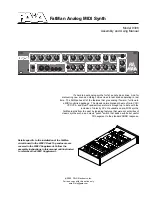
V
oice mode
Performance
mode
Multi mode
Utility mode
File mode
Master mode
Multi V
oice
mode
Sequence Play
mode
Refer
ence
Performance Edit mode
Common Edit
151
Owner’s Manual
[F3] ARP (Arpeggio)
From this display you can set the Arpeggio related parameters.
[SF1] TYPE
Same as in Normal Voice Common Edit. See page 129.
[SF2] LIMIT
[SF3] PLAY FX (Play Effect)
[SF4] OUT CH (Output Channel)
From this display you can set a separate MIDI output channel for the Arpeggio playback data, letting you have
the Arpeggio sound from an external tone generator or synthesizer.
OutputSwitch
When this is set to on, Arpeggio playback data is output via MIDI.
Settings:
on, off
TransmitCh
Determines the MIDI transmit channel for Arpeggio playback data. When set to “KbdCh,” the Arpeggio
playback data is output via the MIDI Keyboard Transmit Channel ([UTILITY]
→
[F5] MIDI
→
KBDTransCh).
Settings:
1 ~ 16, KbdCh (Keyboard Channel)
[F4] CTL ASN (Controller Assign)
You can assign Control Change numbers to the controllers listed below, letting you use the hardware controllers on the keyboard to alter the sound of
external MIDI devices, via the appropriate MIDI messages. When the S90 ES receives Control Change data corresponding to the settings here, the internal
tone generator responds as if the instrument’s controllers were used.
BC (Breath Controller)
Determines the Control Change number generated when you apply breath pressure to the Breath Controller
connected to the BREATH connector.
RB (Ribbon Controller)
The S90 ES does not have a Ribbon Controller. However, the S90 ES responds as if a Ribbon Controller was
used when receiving Control Change messages over the Control Change number determined in this
parameter.
AS1 (Assign 1),
AS2 (Assign 2)
Determines the Control Change number generated when you control the Control slider 3 and the Control slider
4 with both the [PAN/SEND] and [TONE] lamp turned on.
FC1 (Foot Controller 1),
FC2 (Foot Controller 2)
Determines the Control Change number generated when you use the Foot Controller connected to the FOOT
CONTROLLER jack.
n
Keep in mind that the functions of these controllers set here are not changed for the internal tone generator. The controller assignments for the S90 ES itself depend
on the settings of the Voices assigned to each Part.
[F5] AUDIO IN
The audio signal input from the A/D INPUT jack, and mLAN connector (when the optional mLAN16E has been installed to this synthesizer), can be handled
as Audio Input Parts. You can apply various parameters such as Effect settings to these Parts, just as with the other Parts.
n
For details about the Audio Input Parts, see page 118.
[SF1] OUTPUT
Volume
Determines the output level of the Audio Input Part.
Settings:
0 ~ 127
Pan
Determines the stereo pan position of the Audio Input Part.
Settings:
L63 (Left) ~ C (Center) ~ R63 (Right)
RevSend
Determines the Send level of the Audio Input Part signal sent to the Reverb effect.
Settings:
0 ~ 127
ChoSend
Determines the Send level of the Audio Input Part signal sent to the Chorus effect.
Settings:
0 ~ 127
DryLevel
Determines the level of the Audio Input Part which has not been processed with the System Effects (Reverb,
Chorus).
Settings:
0 ~ 127
n
For details about Effect connection in the Performance mode, see page 122.
Mono/Stereo
Determines the signal configuration for the Audio Input Part, or how the signal or signals are routed (stereo or
mono).
Settings:
stereo, L mono, R mono, L+R mono
stereo............... Both the L and R channels of the audio input are used.
L (left) mono .... Only the L channel of the audio input is used.
R (right) mono . Only the R channel of the audio input is used.
L+R mono........ The L and R channels of the audio input are mixed and processed in mono.
OutputSel (Output Select)
Determines the output jack assignment for the Audio Input Part.
Settings:
















































